Analyzing ALDI's Marketing: Audit, Objectives, and Service Functions
VerifiedAdded on 2023/01/12
|12
|3760
|52
Report
AI Summary
This report provides an analysis of ALDI's marketing management strategies, focusing on the marketing audit, TOWS analysis, marketing objectives, marketing mix, and client services. The marketing audit examines both internal and external factors influencing ALDI's performance, while the TOWS analysis assesses strengths, weaknesses, opportunities, and threats. The report highlights the importance of setting clear marketing objectives, such as improving brand image and gaining a competitive advantage. It also discusses how ALDI utilizes the marketing mix (product, price, place, promotion) to effectively reach its target market and maintain a strong brand presence. Finally, the function of client services in building customer loyalty and enhancing brand image is examined. The report concludes with recommendations for ALDI to improve its marketing efforts, such as providing accurate product information and effective promotion.
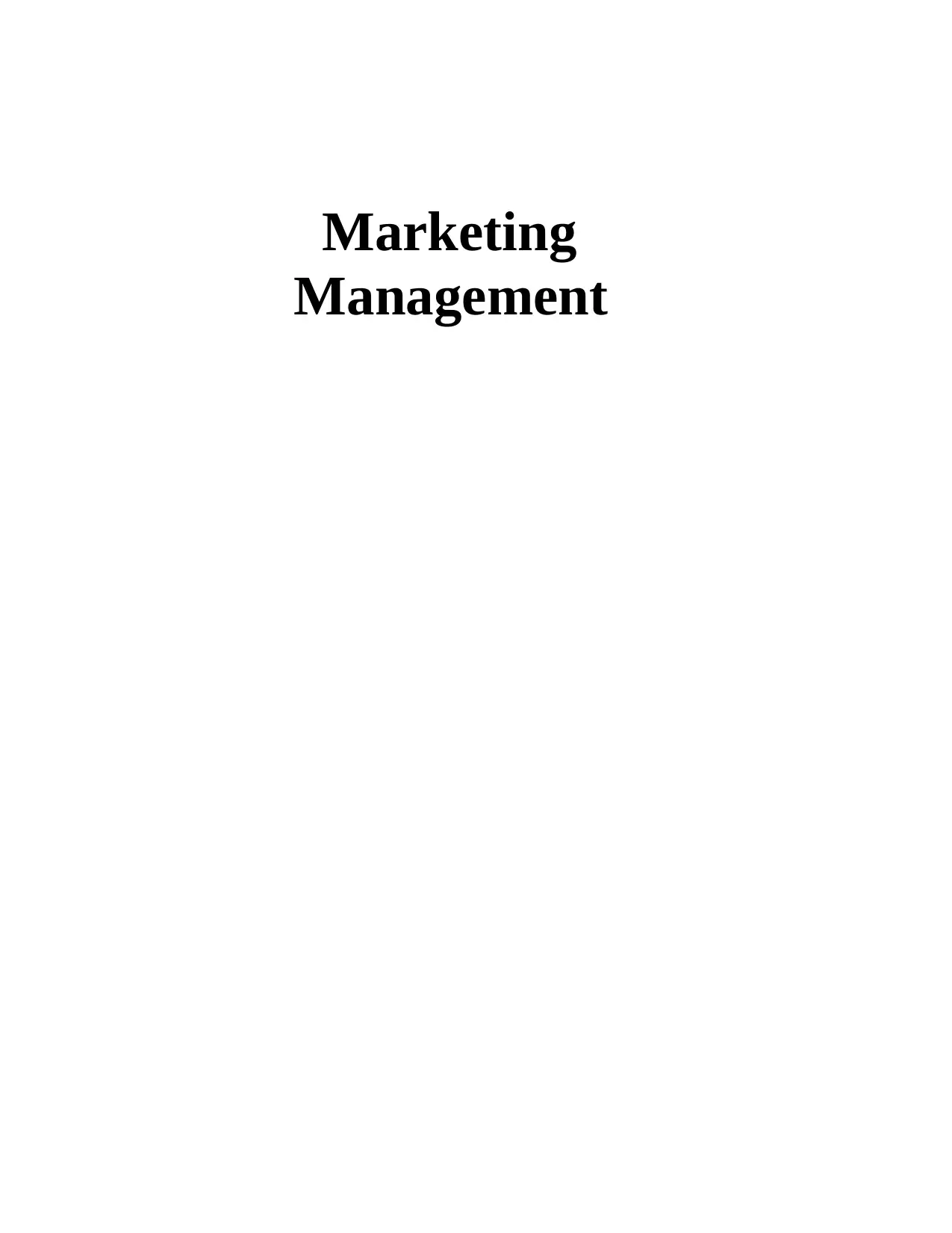
Marketing
Management
Management
Paraphrase This Document
Need a fresh take? Get an instant paraphrase of this document with our AI Paraphraser
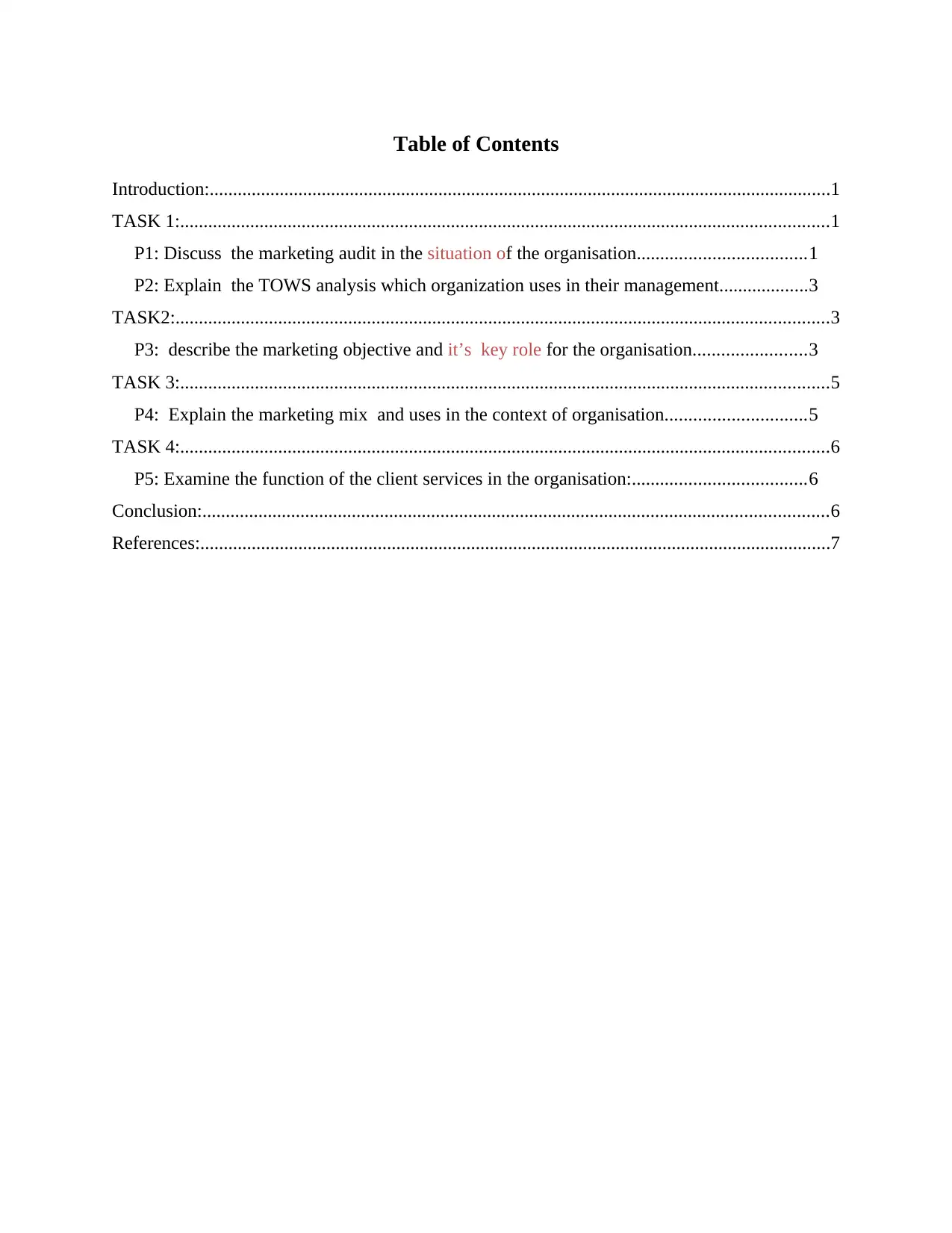
Table of Contents
Introduction:.....................................................................................................................................1
TASK 1:...........................................................................................................................................1
P1: Discuss the marketing audit in the situation of the organisation....................................1
P2: Explain the TOWS analysis which organization uses in their management...................3
TASK2:............................................................................................................................................3
P3: describe the marketing objective and it’s key role for the organisation........................3
TASK 3:...........................................................................................................................................5
P4: Explain the marketing mix and uses in the context of organisation..............................5
TASK 4:...........................................................................................................................................6
P5: Examine the function of the client services in the organisation:.....................................6
Conclusion:......................................................................................................................................6
References:.......................................................................................................................................7
Introduction:.....................................................................................................................................1
TASK 1:...........................................................................................................................................1
P1: Discuss the marketing audit in the situation of the organisation....................................1
P2: Explain the TOWS analysis which organization uses in their management...................3
TASK2:............................................................................................................................................3
P3: describe the marketing objective and it’s key role for the organisation........................3
TASK 3:...........................................................................................................................................5
P4: Explain the marketing mix and uses in the context of organisation..............................5
TASK 4:...........................................................................................................................................6
P5: Examine the function of the client services in the organisation:.....................................6
Conclusion:......................................................................................................................................6
References:.......................................................................................................................................7
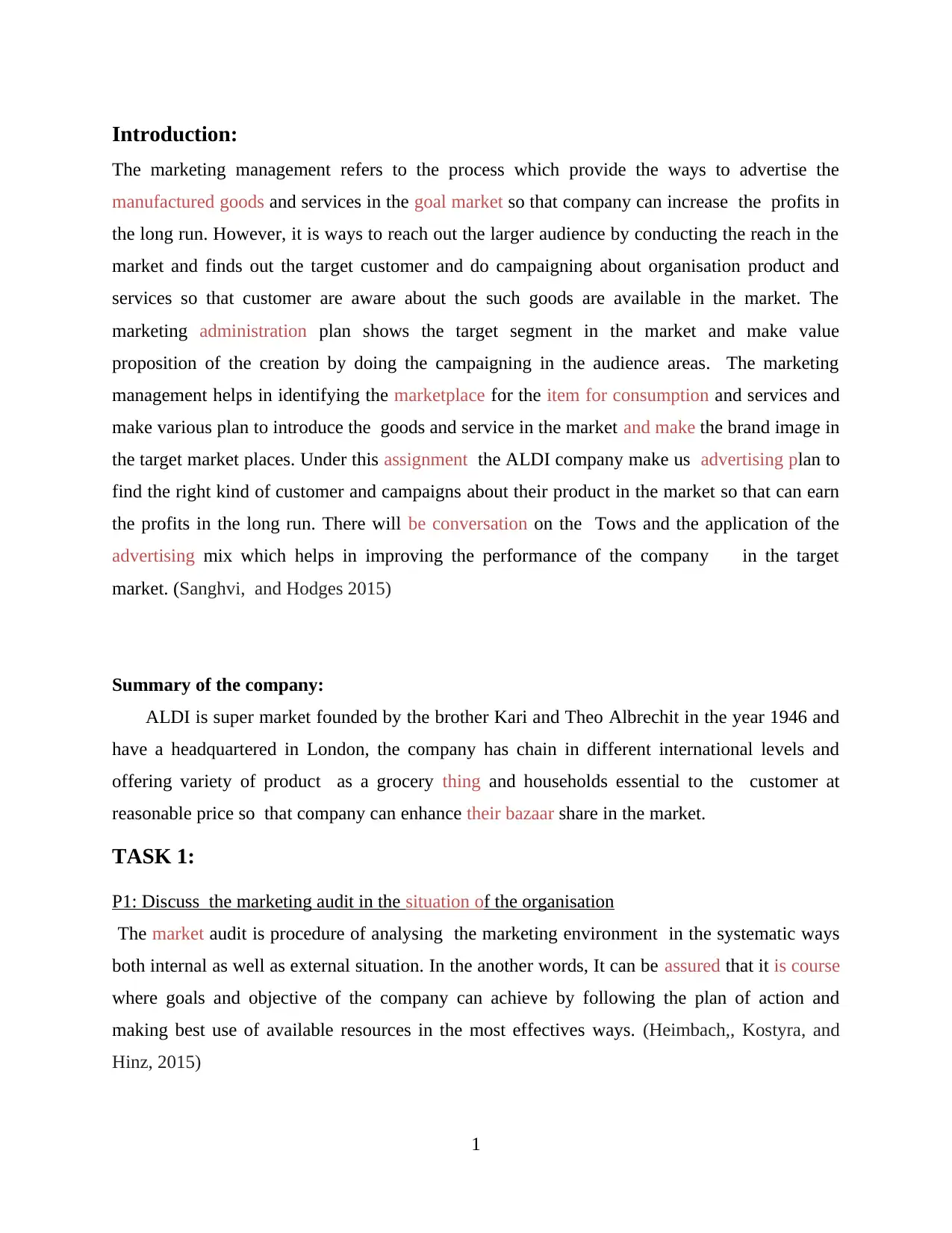
Introduction:
The marketing management refers to the process which provide the ways to advertise the
manufactured goods and services in the goal market so that company can increase the profits in
the long run. However, it is ways to reach out the larger audience by conducting the reach in the
market and finds out the target customer and do campaigning about organisation product and
services so that customer are aware about the such goods are available in the market. The
marketing administration plan shows the target segment in the market and make value
proposition of the creation by doing the campaigning in the audience areas. The marketing
management helps in identifying the marketplace for the item for consumption and services and
make various plan to introduce the goods and service in the market and make the brand image in
the target market places. Under this assignment the ALDI company make us advertising plan to
find the right kind of customer and campaigns about their product in the market so that can earn
the profits in the long run. There will be conversation on the Tows and the application of the
advertising mix which helps in improving the performance of the company in the target
market. (Sanghvi, and Hodges 2015)
Summary of the company:
ALDI is super market founded by the brother Kari and Theo Albrechit in the year 1946 and
have a headquartered in London, the company has chain in different international levels and
offering variety of product as a grocery thing and households essential to the customer at
reasonable price so that company can enhance their bazaar share in the market.
TASK 1:
P1: Discuss the marketing audit in the situation of the organisation
The market audit is procedure of analysing the marketing environment in the systematic ways
both internal as well as external situation. In the another words, It can be assured that it is course
where goals and objective of the company can achieve by following the plan of action and
making best use of available resources in the most effectives ways. (Heimbach,, Kostyra, and
Hinz, 2015)
1
The marketing management refers to the process which provide the ways to advertise the
manufactured goods and services in the goal market so that company can increase the profits in
the long run. However, it is ways to reach out the larger audience by conducting the reach in the
market and finds out the target customer and do campaigning about organisation product and
services so that customer are aware about the such goods are available in the market. The
marketing administration plan shows the target segment in the market and make value
proposition of the creation by doing the campaigning in the audience areas. The marketing
management helps in identifying the marketplace for the item for consumption and services and
make various plan to introduce the goods and service in the market and make the brand image in
the target market places. Under this assignment the ALDI company make us advertising plan to
find the right kind of customer and campaigns about their product in the market so that can earn
the profits in the long run. There will be conversation on the Tows and the application of the
advertising mix which helps in improving the performance of the company in the target
market. (Sanghvi, and Hodges 2015)
Summary of the company:
ALDI is super market founded by the brother Kari and Theo Albrechit in the year 1946 and
have a headquartered in London, the company has chain in different international levels and
offering variety of product as a grocery thing and households essential to the customer at
reasonable price so that company can enhance their bazaar share in the market.
TASK 1:
P1: Discuss the marketing audit in the situation of the organisation
The market audit is procedure of analysing the marketing environment in the systematic ways
both internal as well as external situation. In the another words, It can be assured that it is course
where goals and objective of the company can achieve by following the plan of action and
making best use of available resources in the most effectives ways. (Heimbach,, Kostyra, and
Hinz, 2015)
1
⊘ This is a preview!⊘
Do you want full access?
Subscribe today to unlock all pages.

Trusted by 1+ million students worldwide
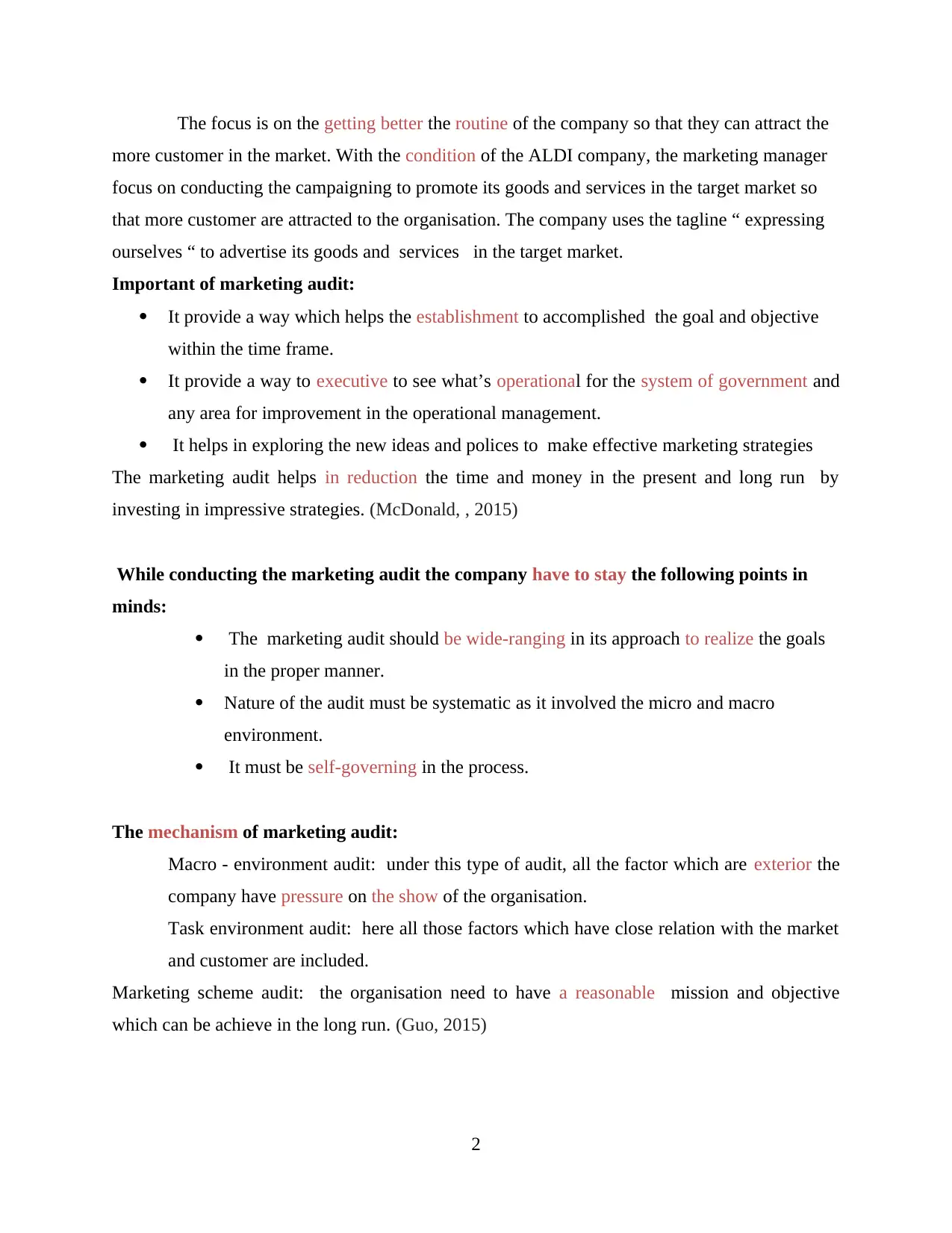
The focus is on the getting better the routine of the company so that they can attract the
more customer in the market. With the condition of the ALDI company, the marketing manager
focus on conducting the campaigning to promote its goods and services in the target market so
that more customer are attracted to the organisation. The company uses the tagline “ expressing
ourselves “ to advertise its goods and services in the target market.
Important of marketing audit:
It provide a way which helps the establishment to accomplished the goal and objective
within the time frame.
It provide a way to executive to see what’s operational for the system of government and
any area for improvement in the operational management.
It helps in exploring the new ideas and polices to make effective marketing strategies
The marketing audit helps in reduction the time and money in the present and long run by
investing in impressive strategies. (McDonald, , 2015)
While conducting the marketing audit the company have to stay the following points in
minds:
The marketing audit should be wide-ranging in its approach to realize the goals
in the proper manner.
Nature of the audit must be systematic as it involved the micro and macro
environment.
It must be self-governing in the process.
The mechanism of marketing audit:
Macro - environment audit: under this type of audit, all the factor which are exterior the
company have pressure on the show of the organisation.
Task environment audit: here all those factors which have close relation with the market
and customer are included.
Marketing scheme audit: the organisation need to have a reasonable mission and objective
which can be achieve in the long run. (Guo, 2015)
2
more customer in the market. With the condition of the ALDI company, the marketing manager
focus on conducting the campaigning to promote its goods and services in the target market so
that more customer are attracted to the organisation. The company uses the tagline “ expressing
ourselves “ to advertise its goods and services in the target market.
Important of marketing audit:
It provide a way which helps the establishment to accomplished the goal and objective
within the time frame.
It provide a way to executive to see what’s operational for the system of government and
any area for improvement in the operational management.
It helps in exploring the new ideas and polices to make effective marketing strategies
The marketing audit helps in reduction the time and money in the present and long run by
investing in impressive strategies. (McDonald, , 2015)
While conducting the marketing audit the company have to stay the following points in
minds:
The marketing audit should be wide-ranging in its approach to realize the goals
in the proper manner.
Nature of the audit must be systematic as it involved the micro and macro
environment.
It must be self-governing in the process.
The mechanism of marketing audit:
Macro - environment audit: under this type of audit, all the factor which are exterior the
company have pressure on the show of the organisation.
Task environment audit: here all those factors which have close relation with the market
and customer are included.
Marketing scheme audit: the organisation need to have a reasonable mission and objective
which can be achieve in the long run. (Guo, 2015)
2
Paraphrase This Document
Need a fresh take? Get an instant paraphrase of this document with our AI Paraphraser
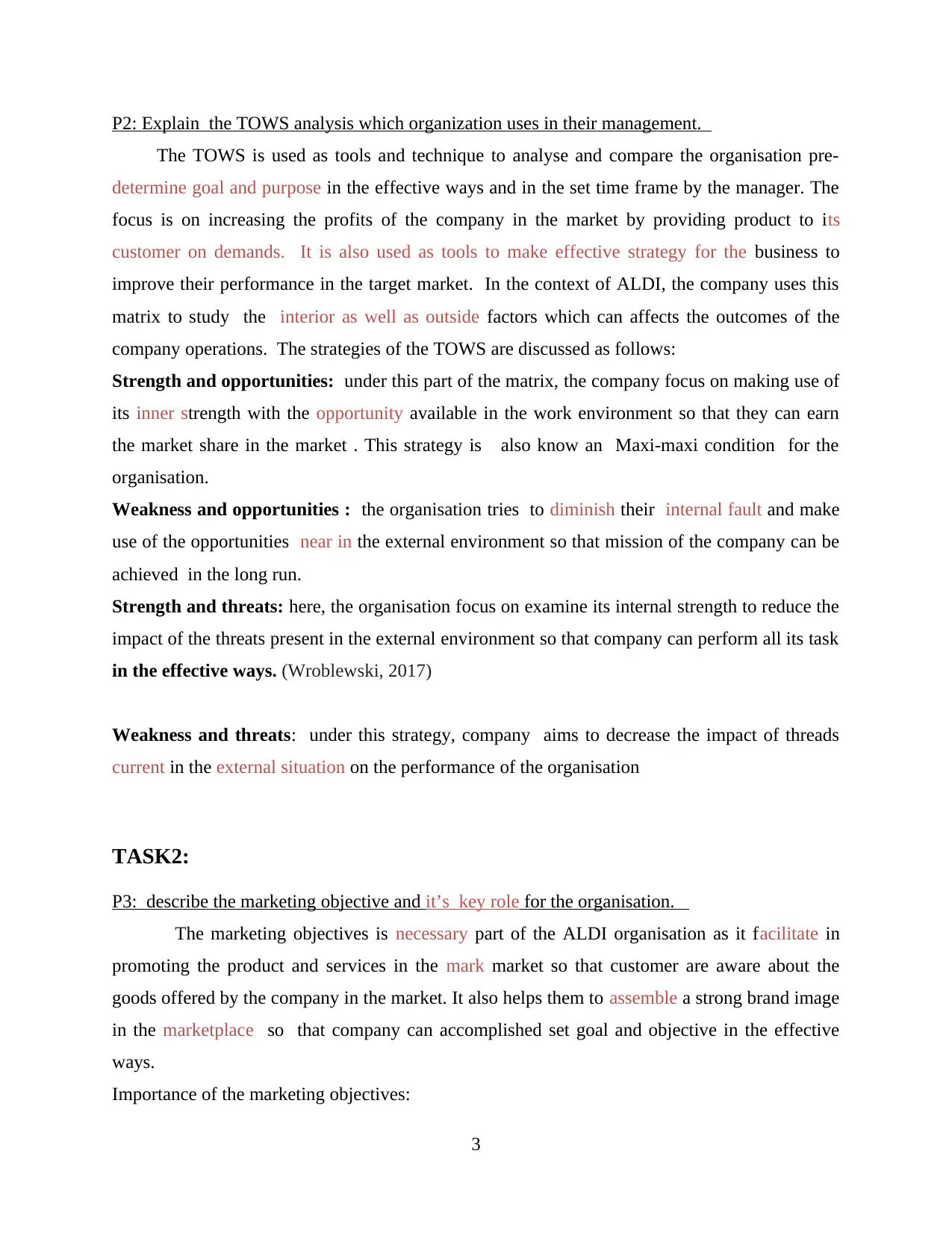
P2: Explain the TOWS analysis which organization uses in their management.
The TOWS is used as tools and technique to analyse and compare the organisation pre-
determine goal and purpose in the effective ways and in the set time frame by the manager. The
focus is on increasing the profits of the company in the market by providing product to its
customer on demands. It is also used as tools to make effective strategy for the business to
improve their performance in the target market. In the context of ALDI, the company uses this
matrix to study the interior as well as outside factors which can affects the outcomes of the
company operations. The strategies of the TOWS are discussed as follows:
Strength and opportunities: under this part of the matrix, the company focus on making use of
its inner strength with the opportunity available in the work environment so that they can earn
the market share in the market . This strategy is also know an Maxi-maxi condition for the
organisation.
Weakness and opportunities : the organisation tries to diminish their internal fault and make
use of the opportunities near in the external environment so that mission of the company can be
achieved in the long run.
Strength and threats: here, the organisation focus on examine its internal strength to reduce the
impact of the threats present in the external environment so that company can perform all its task
in the effective ways. (Wroblewski, 2017)
Weakness and threats: under this strategy, company aims to decrease the impact of threads
current in the external situation on the performance of the organisation
TASK2:
P3: describe the marketing objective and it’s key role for the organisation.
The marketing objectives is necessary part of the ALDI organisation as it facilitate in
promoting the product and services in the mark market so that customer are aware about the
goods offered by the company in the market. It also helps them to assemble a strong brand image
in the marketplace so that company can accomplished set goal and objective in the effective
ways.
Importance of the marketing objectives:
3
The TOWS is used as tools and technique to analyse and compare the organisation pre-
determine goal and purpose in the effective ways and in the set time frame by the manager. The
focus is on increasing the profits of the company in the market by providing product to its
customer on demands. It is also used as tools to make effective strategy for the business to
improve their performance in the target market. In the context of ALDI, the company uses this
matrix to study the interior as well as outside factors which can affects the outcomes of the
company operations. The strategies of the TOWS are discussed as follows:
Strength and opportunities: under this part of the matrix, the company focus on making use of
its inner strength with the opportunity available in the work environment so that they can earn
the market share in the market . This strategy is also know an Maxi-maxi condition for the
organisation.
Weakness and opportunities : the organisation tries to diminish their internal fault and make
use of the opportunities near in the external environment so that mission of the company can be
achieved in the long run.
Strength and threats: here, the organisation focus on examine its internal strength to reduce the
impact of the threats present in the external environment so that company can perform all its task
in the effective ways. (Wroblewski, 2017)
Weakness and threats: under this strategy, company aims to decrease the impact of threads
current in the external situation on the performance of the organisation
TASK2:
P3: describe the marketing objective and it’s key role for the organisation.
The marketing objectives is necessary part of the ALDI organisation as it facilitate in
promoting the product and services in the mark market so that customer are aware about the
goods offered by the company in the market. It also helps them to assemble a strong brand image
in the marketplace so that company can accomplished set goal and objective in the effective
ways.
Importance of the marketing objectives:
3
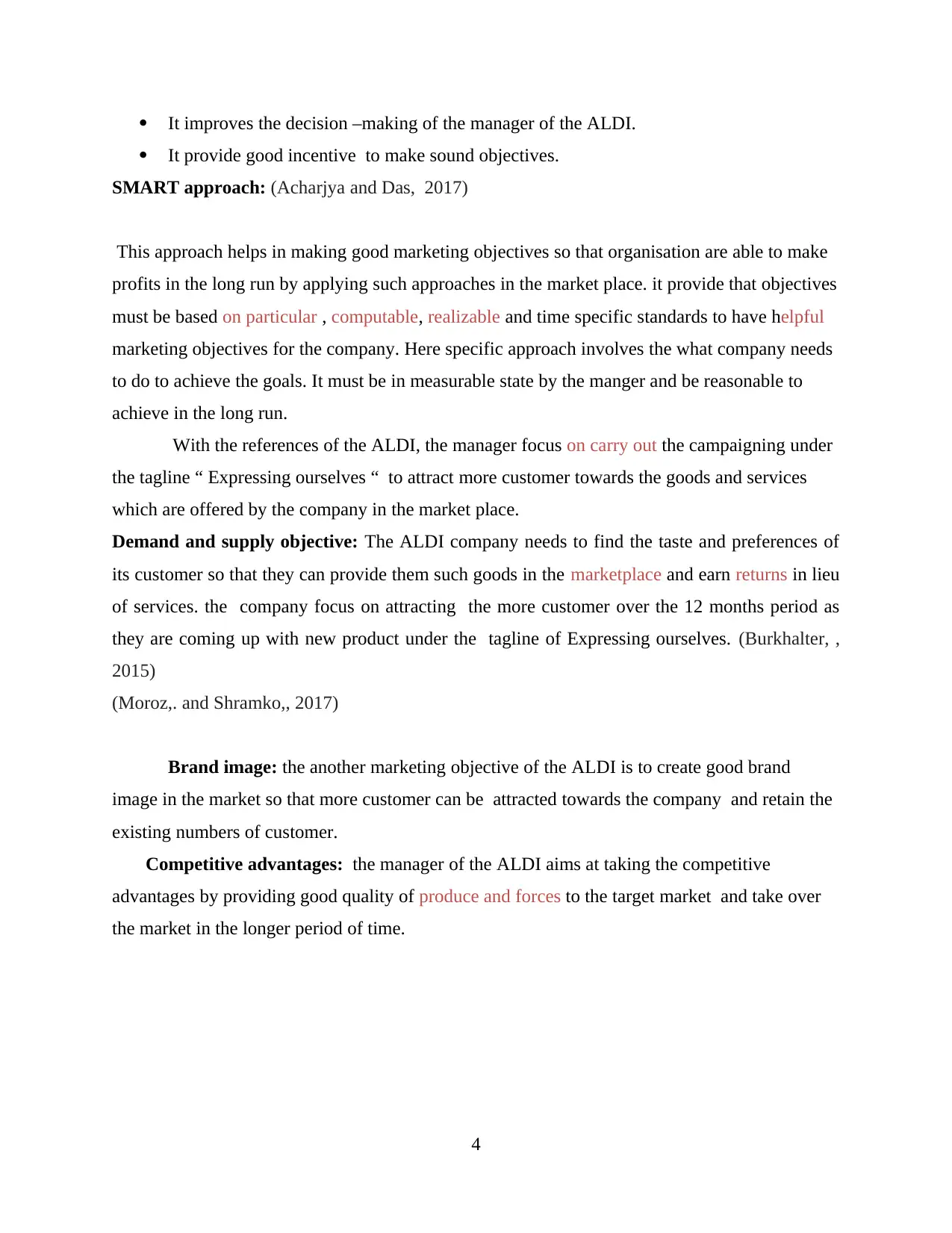
It improves the decision –making of the manager of the ALDI.
It provide good incentive to make sound objectives.
SMART approach: (Acharjya and Das, 2017)
This approach helps in making good marketing objectives so that organisation are able to make
profits in the long run by applying such approaches in the market place. it provide that objectives
must be based on particular , computable, realizable and time specific standards to have helpful
marketing objectives for the company. Here specific approach involves the what company needs
to do to achieve the goals. It must be in measurable state by the manger and be reasonable to
achieve in the long run.
With the references of the ALDI, the manager focus on carry out the campaigning under
the tagline “ Expressing ourselves “ to attract more customer towards the goods and services
which are offered by the company in the market place.
Demand and supply objective: The ALDI company needs to find the taste and preferences of
its customer so that they can provide them such goods in the marketplace and earn returns in lieu
of services. the company focus on attracting the more customer over the 12 months period as
they are coming up with new product under the tagline of Expressing ourselves. (Burkhalter, ,
2015)
(Moroz,. and Shramko,, 2017)
Brand image: the another marketing objective of the ALDI is to create good brand
image in the market so that more customer can be attracted towards the company and retain the
existing numbers of customer.
Competitive advantages: the manager of the ALDI aims at taking the competitive
advantages by providing good quality of produce and forces to the target market and take over
the market in the longer period of time.
4
It provide good incentive to make sound objectives.
SMART approach: (Acharjya and Das, 2017)
This approach helps in making good marketing objectives so that organisation are able to make
profits in the long run by applying such approaches in the market place. it provide that objectives
must be based on particular , computable, realizable and time specific standards to have helpful
marketing objectives for the company. Here specific approach involves the what company needs
to do to achieve the goals. It must be in measurable state by the manger and be reasonable to
achieve in the long run.
With the references of the ALDI, the manager focus on carry out the campaigning under
the tagline “ Expressing ourselves “ to attract more customer towards the goods and services
which are offered by the company in the market place.
Demand and supply objective: The ALDI company needs to find the taste and preferences of
its customer so that they can provide them such goods in the marketplace and earn returns in lieu
of services. the company focus on attracting the more customer over the 12 months period as
they are coming up with new product under the tagline of Expressing ourselves. (Burkhalter, ,
2015)
(Moroz,. and Shramko,, 2017)
Brand image: the another marketing objective of the ALDI is to create good brand
image in the market so that more customer can be attracted towards the company and retain the
existing numbers of customer.
Competitive advantages: the manager of the ALDI aims at taking the competitive
advantages by providing good quality of produce and forces to the target market and take over
the market in the longer period of time.
4
⊘ This is a preview!⊘
Do you want full access?
Subscribe today to unlock all pages.

Trusted by 1+ million students worldwide
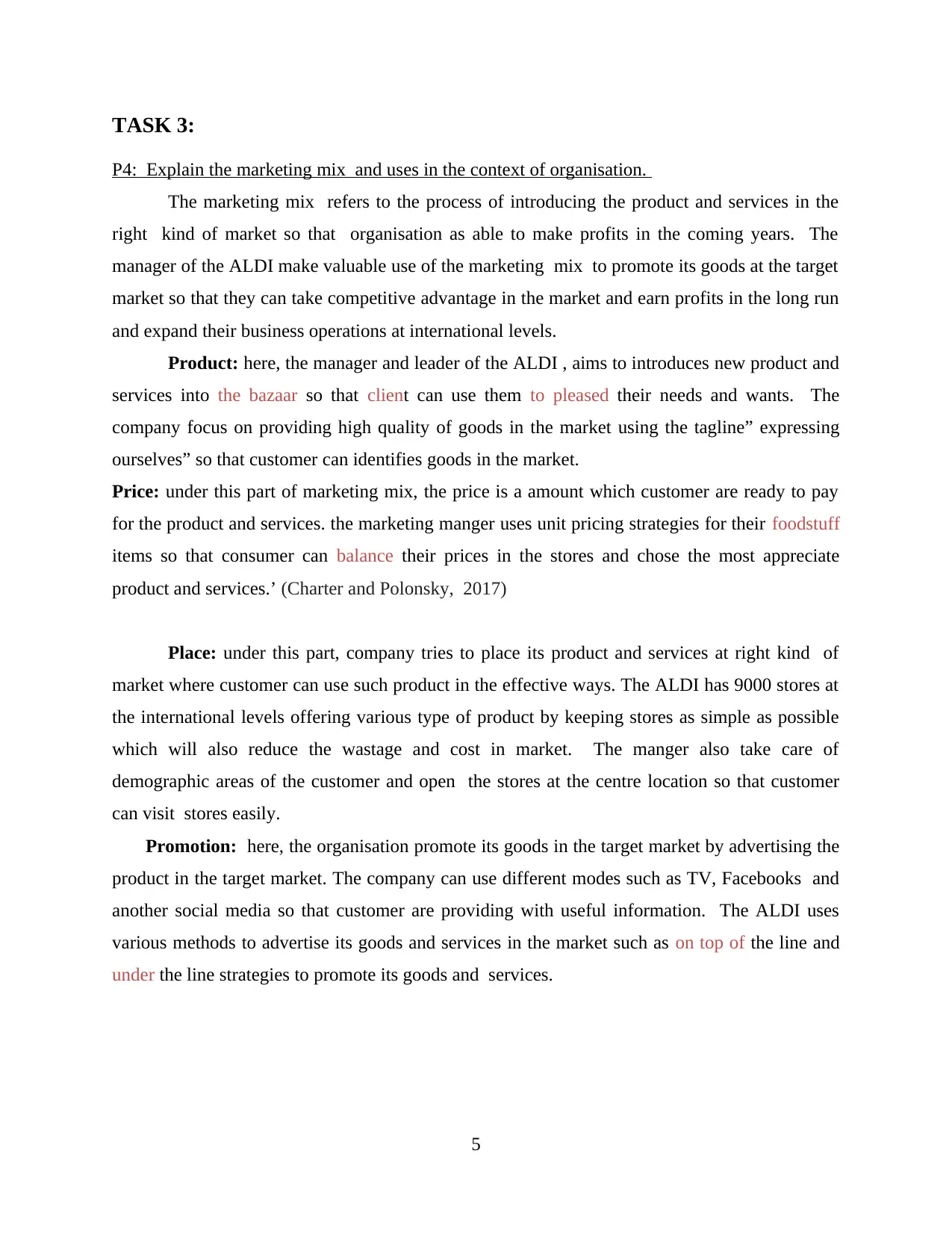
TASK 3:
P4: Explain the marketing mix and uses in the context of organisation.
The marketing mix refers to the process of introducing the product and services in the
right kind of market so that organisation as able to make profits in the coming years. The
manager of the ALDI make valuable use of the marketing mix to promote its goods at the target
market so that they can take competitive advantage in the market and earn profits in the long run
and expand their business operations at international levels.
Product: here, the manager and leader of the ALDI , aims to introduces new product and
services into the bazaar so that client can use them to pleased their needs and wants. The
company focus on providing high quality of goods in the market using the tagline” expressing
ourselves” so that customer can identifies goods in the market.
Price: under this part of marketing mix, the price is a amount which customer are ready to pay
for the product and services. the marketing manger uses unit pricing strategies for their foodstuff
items so that consumer can balance their prices in the stores and chose the most appreciate
product and services.’ (Charter and Polonsky, 2017)
Place: under this part, company tries to place its product and services at right kind of
market where customer can use such product in the effective ways. The ALDI has 9000 stores at
the international levels offering various type of product by keeping stores as simple as possible
which will also reduce the wastage and cost in market. The manger also take care of
demographic areas of the customer and open the stores at the centre location so that customer
can visit stores easily.
Promotion: here, the organisation promote its goods in the target market by advertising the
product in the target market. The company can use different modes such as TV, Facebooks and
another social media so that customer are providing with useful information. The ALDI uses
various methods to advertise its goods and services in the market such as on top of the line and
under the line strategies to promote its goods and services.
5
P4: Explain the marketing mix and uses in the context of organisation.
The marketing mix refers to the process of introducing the product and services in the
right kind of market so that organisation as able to make profits in the coming years. The
manager of the ALDI make valuable use of the marketing mix to promote its goods at the target
market so that they can take competitive advantage in the market and earn profits in the long run
and expand their business operations at international levels.
Product: here, the manager and leader of the ALDI , aims to introduces new product and
services into the bazaar so that client can use them to pleased their needs and wants. The
company focus on providing high quality of goods in the market using the tagline” expressing
ourselves” so that customer can identifies goods in the market.
Price: under this part of marketing mix, the price is a amount which customer are ready to pay
for the product and services. the marketing manger uses unit pricing strategies for their foodstuff
items so that consumer can balance their prices in the stores and chose the most appreciate
product and services.’ (Charter and Polonsky, 2017)
Place: under this part, company tries to place its product and services at right kind of
market where customer can use such product in the effective ways. The ALDI has 9000 stores at
the international levels offering various type of product by keeping stores as simple as possible
which will also reduce the wastage and cost in market. The manger also take care of
demographic areas of the customer and open the stores at the centre location so that customer
can visit stores easily.
Promotion: here, the organisation promote its goods in the target market by advertising the
product in the target market. The company can use different modes such as TV, Facebooks and
another social media so that customer are providing with useful information. The ALDI uses
various methods to advertise its goods and services in the market such as on top of the line and
under the line strategies to promote its goods and services.
5
Paraphrase This Document
Need a fresh take? Get an instant paraphrase of this document with our AI Paraphraser
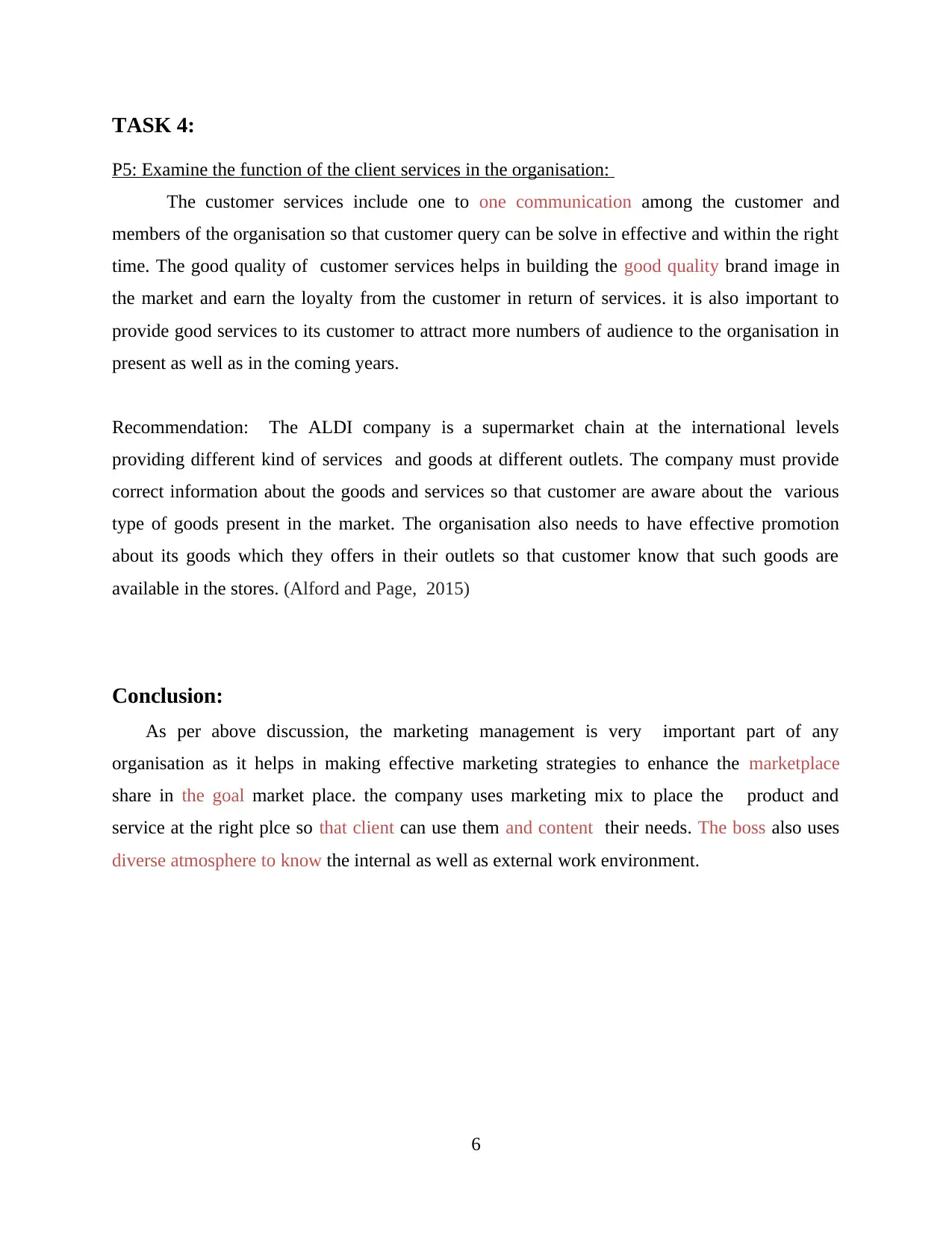
TASK 4:
P5: Examine the function of the client services in the organisation:
The customer services include one to one communication among the customer and
members of the organisation so that customer query can be solve in effective and within the right
time. The good quality of customer services helps in building the good quality brand image in
the market and earn the loyalty from the customer in return of services. it is also important to
provide good services to its customer to attract more numbers of audience to the organisation in
present as well as in the coming years.
Recommendation: The ALDI company is a supermarket chain at the international levels
providing different kind of services and goods at different outlets. The company must provide
correct information about the goods and services so that customer are aware about the various
type of goods present in the market. The organisation also needs to have effective promotion
about its goods which they offers in their outlets so that customer know that such goods are
available in the stores. (Alford and Page, 2015)
Conclusion:
As per above discussion, the marketing management is very important part of any
organisation as it helps in making effective marketing strategies to enhance the marketplace
share in the goal market place. the company uses marketing mix to place the product and
service at the right plce so that client can use them and content their needs. The boss also uses
diverse atmosphere to know the internal as well as external work environment.
6
P5: Examine the function of the client services in the organisation:
The customer services include one to one communication among the customer and
members of the organisation so that customer query can be solve in effective and within the right
time. The good quality of customer services helps in building the good quality brand image in
the market and earn the loyalty from the customer in return of services. it is also important to
provide good services to its customer to attract more numbers of audience to the organisation in
present as well as in the coming years.
Recommendation: The ALDI company is a supermarket chain at the international levels
providing different kind of services and goods at different outlets. The company must provide
correct information about the goods and services so that customer are aware about the various
type of goods present in the market. The organisation also needs to have effective promotion
about its goods which they offers in their outlets so that customer know that such goods are
available in the stores. (Alford and Page, 2015)
Conclusion:
As per above discussion, the marketing management is very important part of any
organisation as it helps in making effective marketing strategies to enhance the marketplace
share in the goal market place. the company uses marketing mix to place the product and
service at the right plce so that client can use them and content their needs. The boss also uses
diverse atmosphere to know the internal as well as external work environment.
6
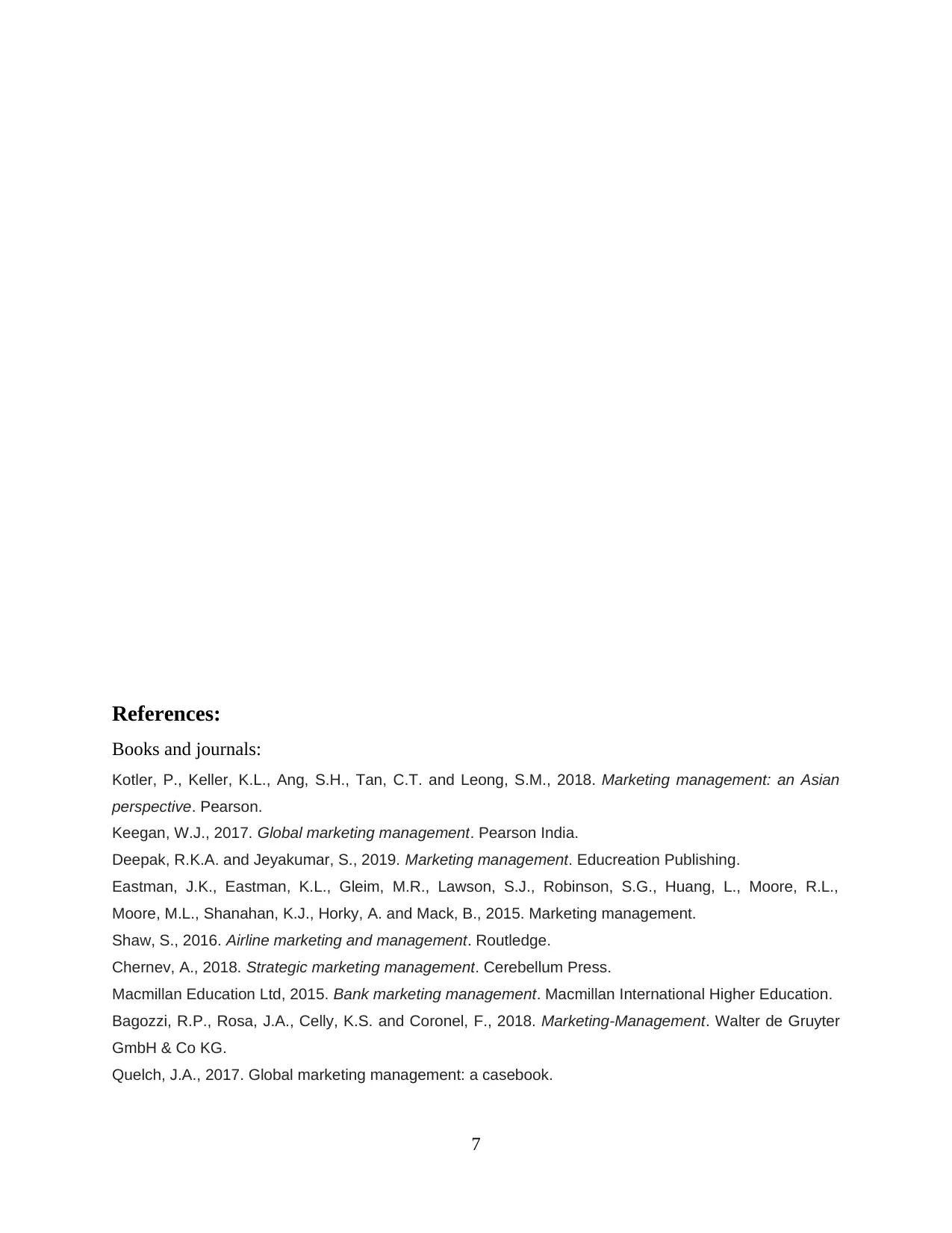
References:
Books and journals:
Kotler, P., Keller, K.L., Ang, S.H., Tan, C.T. and Leong, S.M., 2018. Marketing management: an Asian
perspective. Pearson.
Keegan, W.J., 2017. Global marketing management. Pearson India.
Deepak, R.K.A. and Jeyakumar, S., 2019. Marketing management. Educreation Publishing.
Eastman, J.K., Eastman, K.L., Gleim, M.R., Lawson, S.J., Robinson, S.G., Huang, L., Moore, R.L.,
Moore, M.L., Shanahan, K.J., Horky, A. and Mack, B., 2015. Marketing management.
Shaw, S., 2016. Airline marketing and management. Routledge.
Chernev, A., 2018. Strategic marketing management. Cerebellum Press.
Macmillan Education Ltd, 2015. Bank marketing management. Macmillan International Higher Education.
Bagozzi, R.P., Rosa, J.A., Celly, K.S. and Coronel, F., 2018. Marketing-Management. Walter de Gruyter
GmbH & Co KG.
Quelch, J.A., 2017. Global marketing management: a casebook.
7
Books and journals:
Kotler, P., Keller, K.L., Ang, S.H., Tan, C.T. and Leong, S.M., 2018. Marketing management: an Asian
perspective. Pearson.
Keegan, W.J., 2017. Global marketing management. Pearson India.
Deepak, R.K.A. and Jeyakumar, S., 2019. Marketing management. Educreation Publishing.
Eastman, J.K., Eastman, K.L., Gleim, M.R., Lawson, S.J., Robinson, S.G., Huang, L., Moore, R.L.,
Moore, M.L., Shanahan, K.J., Horky, A. and Mack, B., 2015. Marketing management.
Shaw, S., 2016. Airline marketing and management. Routledge.
Chernev, A., 2018. Strategic marketing management. Cerebellum Press.
Macmillan Education Ltd, 2015. Bank marketing management. Macmillan International Higher Education.
Bagozzi, R.P., Rosa, J.A., Celly, K.S. and Coronel, F., 2018. Marketing-Management. Walter de Gruyter
GmbH & Co KG.
Quelch, J.A., 2017. Global marketing management: a casebook.
7
⊘ This is a preview!⊘
Do you want full access?
Subscribe today to unlock all pages.

Trusted by 1+ million students worldwide
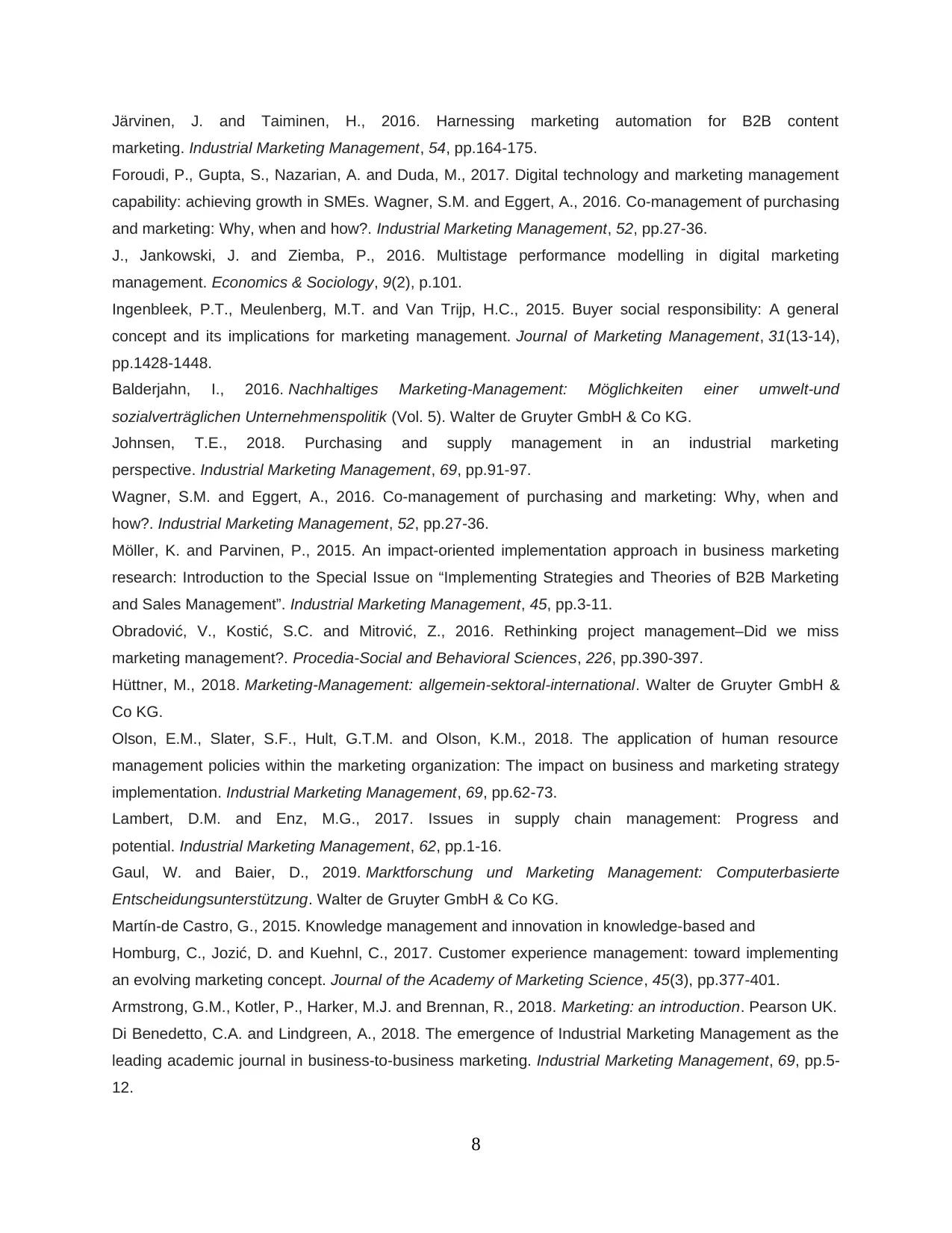
Järvinen, J. and Taiminen, H., 2016. Harnessing marketing automation for B2B content
marketing. Industrial Marketing Management, 54, pp.164-175.
Foroudi, P., Gupta, S., Nazarian, A. and Duda, M., 2017. Digital technology and marketing management
capability: achieving growth in SMEs. Wagner, S.M. and Eggert, A., 2016. Co-management of purchasing
and marketing: Why, when and how?. Industrial Marketing Management, 52, pp.27-36.
J., Jankowski, J. and Ziemba, P., 2016. Multistage performance modelling in digital marketing
management. Economics & Sociology, 9(2), p.101.
Ingenbleek, P.T., Meulenberg, M.T. and Van Trijp, H.C., 2015. Buyer social responsibility: A general
concept and its implications for marketing management. Journal of Marketing Management, 31(13-14),
pp.1428-1448.
Balderjahn, I., 2016. Nachhaltiges Marketing-Management: Möglichkeiten einer umwelt-und
sozialverträglichen Unternehmenspolitik (Vol. 5). Walter de Gruyter GmbH & Co KG.
Johnsen, T.E., 2018. Purchasing and supply management in an industrial marketing
perspective. Industrial Marketing Management, 69, pp.91-97.
Wagner, S.M. and Eggert, A., 2016. Co-management of purchasing and marketing: Why, when and
how?. Industrial Marketing Management, 52, pp.27-36.
Möller, K. and Parvinen, P., 2015. An impact-oriented implementation approach in business marketing
research: Introduction to the Special Issue on “Implementing Strategies and Theories of B2B Marketing
and Sales Management”. Industrial Marketing Management, 45, pp.3-11.
Obradović, V., Kostić, S.C. and Mitrović, Z., 2016. Rethinking project management–Did we miss
marketing management?. Procedia-Social and Behavioral Sciences, 226, pp.390-397.
Hüttner, M., 2018. Marketing-Management: allgemein-sektoral-international. Walter de Gruyter GmbH &
Co KG.
Olson, E.M., Slater, S.F., Hult, G.T.M. and Olson, K.M., 2018. The application of human resource
management policies within the marketing organization: The impact on business and marketing strategy
implementation. Industrial Marketing Management, 69, pp.62-73.
Lambert, D.M. and Enz, M.G., 2017. Issues in supply chain management: Progress and
potential. Industrial Marketing Management, 62, pp.1-16.
Gaul, W. and Baier, D., 2019. Marktforschung und Marketing Management: Computerbasierte
Entscheidungsunterstützung. Walter de Gruyter GmbH & Co KG.
Martín-de Castro, G., 2015. Knowledge management and innovation in knowledge-based and
Homburg, C., Jozić, D. and Kuehnl, C., 2017. Customer experience management: toward implementing
an evolving marketing concept. Journal of the Academy of Marketing Science, 45(3), pp.377-401.
Armstrong, G.M., Kotler, P., Harker, M.J. and Brennan, R., 2018. Marketing: an introduction. Pearson UK.
Di Benedetto, C.A. and Lindgreen, A., 2018. The emergence of Industrial Marketing Management as the
leading academic journal in business-to-business marketing. Industrial Marketing Management, 69, pp.5-
12.
8
marketing. Industrial Marketing Management, 54, pp.164-175.
Foroudi, P., Gupta, S., Nazarian, A. and Duda, M., 2017. Digital technology and marketing management
capability: achieving growth in SMEs. Wagner, S.M. and Eggert, A., 2016. Co-management of purchasing
and marketing: Why, when and how?. Industrial Marketing Management, 52, pp.27-36.
J., Jankowski, J. and Ziemba, P., 2016. Multistage performance modelling in digital marketing
management. Economics & Sociology, 9(2), p.101.
Ingenbleek, P.T., Meulenberg, M.T. and Van Trijp, H.C., 2015. Buyer social responsibility: A general
concept and its implications for marketing management. Journal of Marketing Management, 31(13-14),
pp.1428-1448.
Balderjahn, I., 2016. Nachhaltiges Marketing-Management: Möglichkeiten einer umwelt-und
sozialverträglichen Unternehmenspolitik (Vol. 5). Walter de Gruyter GmbH & Co KG.
Johnsen, T.E., 2018. Purchasing and supply management in an industrial marketing
perspective. Industrial Marketing Management, 69, pp.91-97.
Wagner, S.M. and Eggert, A., 2016. Co-management of purchasing and marketing: Why, when and
how?. Industrial Marketing Management, 52, pp.27-36.
Möller, K. and Parvinen, P., 2015. An impact-oriented implementation approach in business marketing
research: Introduction to the Special Issue on “Implementing Strategies and Theories of B2B Marketing
and Sales Management”. Industrial Marketing Management, 45, pp.3-11.
Obradović, V., Kostić, S.C. and Mitrović, Z., 2016. Rethinking project management–Did we miss
marketing management?. Procedia-Social and Behavioral Sciences, 226, pp.390-397.
Hüttner, M., 2018. Marketing-Management: allgemein-sektoral-international. Walter de Gruyter GmbH &
Co KG.
Olson, E.M., Slater, S.F., Hult, G.T.M. and Olson, K.M., 2018. The application of human resource
management policies within the marketing organization: The impact on business and marketing strategy
implementation. Industrial Marketing Management, 69, pp.62-73.
Lambert, D.M. and Enz, M.G., 2017. Issues in supply chain management: Progress and
potential. Industrial Marketing Management, 62, pp.1-16.
Gaul, W. and Baier, D., 2019. Marktforschung und Marketing Management: Computerbasierte
Entscheidungsunterstützung. Walter de Gruyter GmbH & Co KG.
Martín-de Castro, G., 2015. Knowledge management and innovation in knowledge-based and
Homburg, C., Jozić, D. and Kuehnl, C., 2017. Customer experience management: toward implementing
an evolving marketing concept. Journal of the Academy of Marketing Science, 45(3), pp.377-401.
Armstrong, G.M., Kotler, P., Harker, M.J. and Brennan, R., 2018. Marketing: an introduction. Pearson UK.
Di Benedetto, C.A. and Lindgreen, A., 2018. The emergence of Industrial Marketing Management as the
leading academic journal in business-to-business marketing. Industrial Marketing Management, 69, pp.5-
12.
8
Paraphrase This Document
Need a fresh take? Get an instant paraphrase of this document with our AI Paraphraser
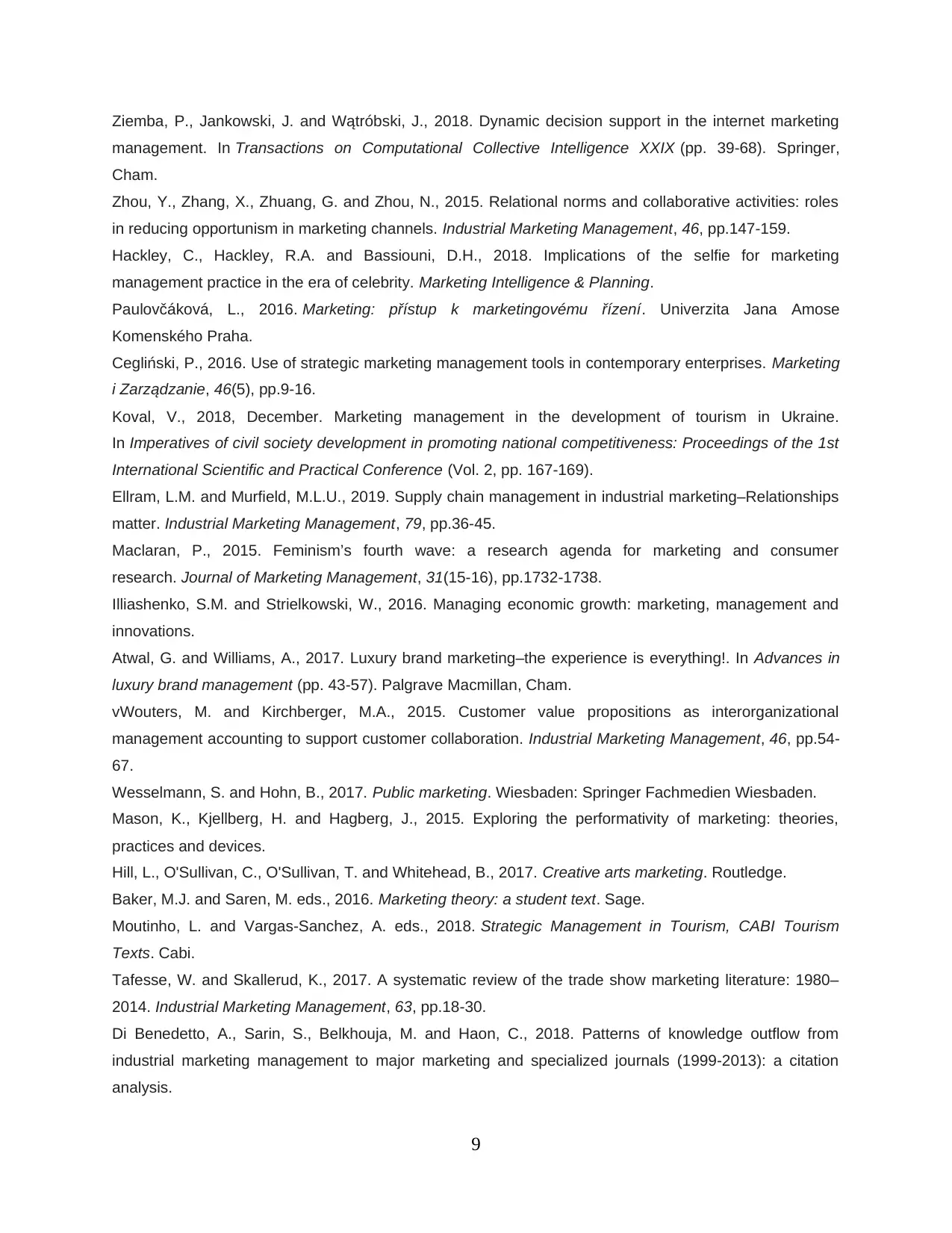
Ziemba, P., Jankowski, J. and Wątróbski, J., 2018. Dynamic decision support in the internet marketing
management. In Transactions on Computational Collective Intelligence XXIX (pp. 39-68). Springer,
Cham.
Zhou, Y., Zhang, X., Zhuang, G. and Zhou, N., 2015. Relational norms and collaborative activities: roles
in reducing opportunism in marketing channels. Industrial Marketing Management, 46, pp.147-159.
Hackley, C., Hackley, R.A. and Bassiouni, D.H., 2018. Implications of the selfie for marketing
management practice in the era of celebrity. Marketing Intelligence & Planning.
Paulovčáková, L., 2016. Marketing: přístup k marketingovému řízení. Univerzita Jana Amose
Komenského Praha.
Cegliński, P., 2016. Use of strategic marketing management tools in contemporary enterprises. Marketing
i Zarządzanie, 46(5), pp.9-16.
Koval, V., 2018, December. Marketing management in the development of tourism in Ukraine.
In Imperatives of civil society development in promoting national competitiveness: Proceedings of the 1st
International Scientific and Practical Conference (Vol. 2, pp. 167-169).
Ellram, L.M. and Murfield, M.L.U., 2019. Supply chain management in industrial marketing–Relationships
matter. Industrial Marketing Management, 79, pp.36-45.
Maclaran, P., 2015. Feminism’s fourth wave: a research agenda for marketing and consumer
research. Journal of Marketing Management, 31(15-16), pp.1732-1738.
Illiashenko, S.M. and Strielkowski, W., 2016. Managing economic growth: marketing, management and
innovations.
Atwal, G. and Williams, A., 2017. Luxury brand marketing–the experience is everything!. In Advances in
luxury brand management (pp. 43-57). Palgrave Macmillan, Cham.
vWouters, M. and Kirchberger, M.A., 2015. Customer value propositions as interorganizational
management accounting to support customer collaboration. Industrial Marketing Management, 46, pp.54-
67.
Wesselmann, S. and Hohn, B., 2017. Public marketing. Wiesbaden: Springer Fachmedien Wiesbaden.
Mason, K., Kjellberg, H. and Hagberg, J., 2015. Exploring the performativity of marketing: theories,
practices and devices.
Hill, L., O'Sullivan, C., O'Sullivan, T. and Whitehead, B., 2017. Creative arts marketing. Routledge.
Baker, M.J. and Saren, M. eds., 2016. Marketing theory: a student text. Sage.
Moutinho, L. and Vargas-Sanchez, A. eds., 2018. Strategic Management in Tourism, CABI Tourism
Texts. Cabi.
Tafesse, W. and Skallerud, K., 2017. A systematic review of the trade show marketing literature: 1980–
2014. Industrial Marketing Management, 63, pp.18-30.
Di Benedetto, A., Sarin, S., Belkhouja, M. and Haon, C., 2018. Patterns of knowledge outflow from
industrial marketing management to major marketing and specialized journals (1999-2013): a citation
analysis.
9
management. In Transactions on Computational Collective Intelligence XXIX (pp. 39-68). Springer,
Cham.
Zhou, Y., Zhang, X., Zhuang, G. and Zhou, N., 2015. Relational norms and collaborative activities: roles
in reducing opportunism in marketing channels. Industrial Marketing Management, 46, pp.147-159.
Hackley, C., Hackley, R.A. and Bassiouni, D.H., 2018. Implications of the selfie for marketing
management practice in the era of celebrity. Marketing Intelligence & Planning.
Paulovčáková, L., 2016. Marketing: přístup k marketingovému řízení. Univerzita Jana Amose
Komenského Praha.
Cegliński, P., 2016. Use of strategic marketing management tools in contemporary enterprises. Marketing
i Zarządzanie, 46(5), pp.9-16.
Koval, V., 2018, December. Marketing management in the development of tourism in Ukraine.
In Imperatives of civil society development in promoting national competitiveness: Proceedings of the 1st
International Scientific and Practical Conference (Vol. 2, pp. 167-169).
Ellram, L.M. and Murfield, M.L.U., 2019. Supply chain management in industrial marketing–Relationships
matter. Industrial Marketing Management, 79, pp.36-45.
Maclaran, P., 2015. Feminism’s fourth wave: a research agenda for marketing and consumer
research. Journal of Marketing Management, 31(15-16), pp.1732-1738.
Illiashenko, S.M. and Strielkowski, W., 2016. Managing economic growth: marketing, management and
innovations.
Atwal, G. and Williams, A., 2017. Luxury brand marketing–the experience is everything!. In Advances in
luxury brand management (pp. 43-57). Palgrave Macmillan, Cham.
vWouters, M. and Kirchberger, M.A., 2015. Customer value propositions as interorganizational
management accounting to support customer collaboration. Industrial Marketing Management, 46, pp.54-
67.
Wesselmann, S. and Hohn, B., 2017. Public marketing. Wiesbaden: Springer Fachmedien Wiesbaden.
Mason, K., Kjellberg, H. and Hagberg, J., 2015. Exploring the performativity of marketing: theories,
practices and devices.
Hill, L., O'Sullivan, C., O'Sullivan, T. and Whitehead, B., 2017. Creative arts marketing. Routledge.
Baker, M.J. and Saren, M. eds., 2016. Marketing theory: a student text. Sage.
Moutinho, L. and Vargas-Sanchez, A. eds., 2018. Strategic Management in Tourism, CABI Tourism
Texts. Cabi.
Tafesse, W. and Skallerud, K., 2017. A systematic review of the trade show marketing literature: 1980–
2014. Industrial Marketing Management, 63, pp.18-30.
Di Benedetto, A., Sarin, S., Belkhouja, M. and Haon, C., 2018. Patterns of knowledge outflow from
industrial marketing management to major marketing and specialized journals (1999-2013): a citation
analysis.
9
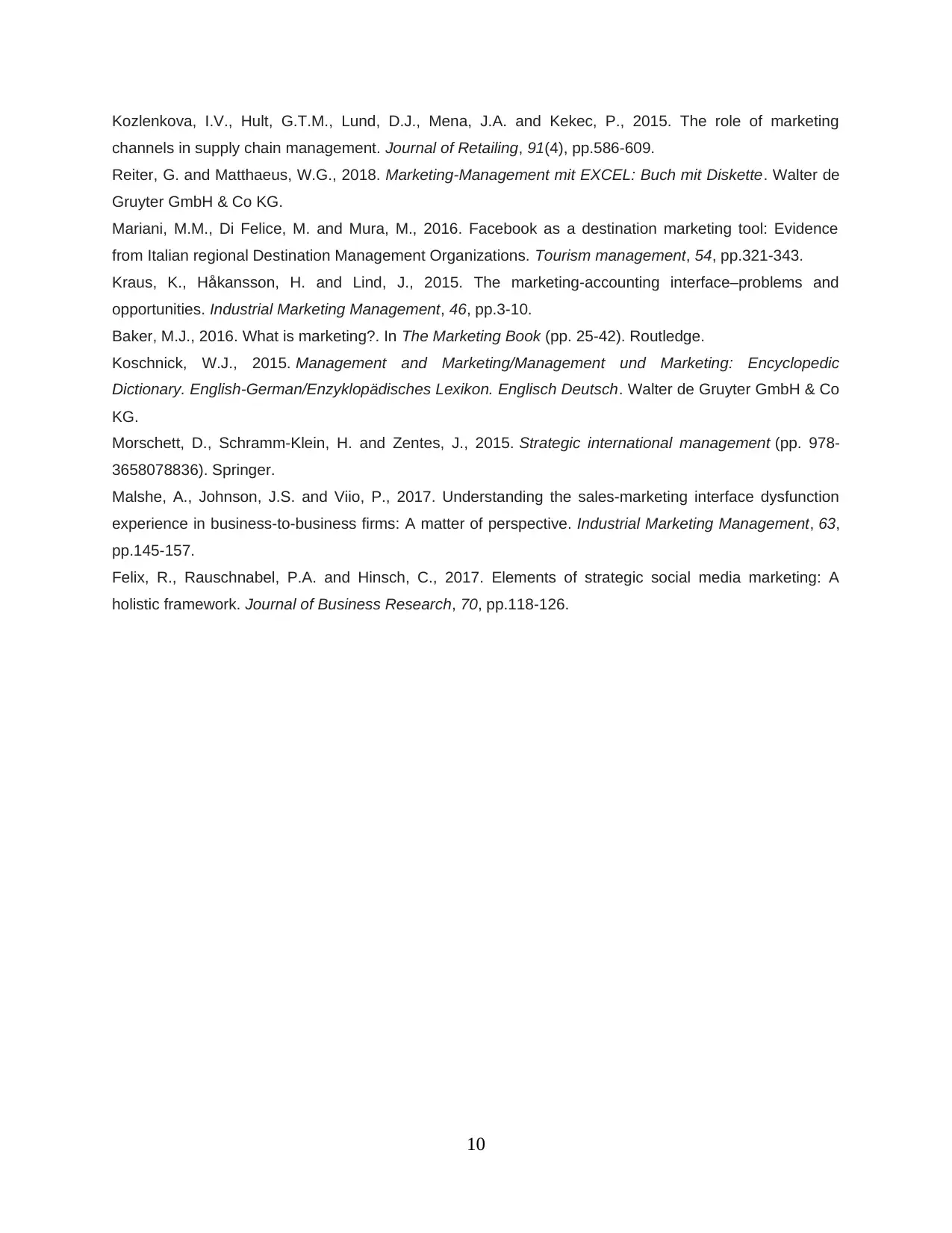
Kozlenkova, I.V., Hult, G.T.M., Lund, D.J., Mena, J.A. and Kekec, P., 2015. The role of marketing
channels in supply chain management. Journal of Retailing, 91(4), pp.586-609.
Reiter, G. and Matthaeus, W.G., 2018. Marketing-Management mit EXCEL: Buch mit Diskette. Walter de
Gruyter GmbH & Co KG.
Mariani, M.M., Di Felice, M. and Mura, M., 2016. Facebook as a destination marketing tool: Evidence
from Italian regional Destination Management Organizations. Tourism management, 54, pp.321-343.
Kraus, K., Håkansson, H. and Lind, J., 2015. The marketing-accounting interface–problems and
opportunities. Industrial Marketing Management, 46, pp.3-10.
Baker, M.J., 2016. What is marketing?. In The Marketing Book (pp. 25-42). Routledge.
Koschnick, W.J., 2015. Management and Marketing/Management und Marketing: Encyclopedic
Dictionary. English-German/Enzyklopädisches Lexikon. Englisch Deutsch. Walter de Gruyter GmbH & Co
KG.
Morschett, D., Schramm-Klein, H. and Zentes, J., 2015. Strategic international management (pp. 978-
3658078836). Springer.
Malshe, A., Johnson, J.S. and Viio, P., 2017. Understanding the sales-marketing interface dysfunction
experience in business-to-business firms: A matter of perspective. Industrial Marketing Management, 63,
pp.145-157.
Felix, R., Rauschnabel, P.A. and Hinsch, C., 2017. Elements of strategic social media marketing: A
holistic framework. Journal of Business Research, 70, pp.118-126.
10
channels in supply chain management. Journal of Retailing, 91(4), pp.586-609.
Reiter, G. and Matthaeus, W.G., 2018. Marketing-Management mit EXCEL: Buch mit Diskette. Walter de
Gruyter GmbH & Co KG.
Mariani, M.M., Di Felice, M. and Mura, M., 2016. Facebook as a destination marketing tool: Evidence
from Italian regional Destination Management Organizations. Tourism management, 54, pp.321-343.
Kraus, K., Håkansson, H. and Lind, J., 2015. The marketing-accounting interface–problems and
opportunities. Industrial Marketing Management, 46, pp.3-10.
Baker, M.J., 2016. What is marketing?. In The Marketing Book (pp. 25-42). Routledge.
Koschnick, W.J., 2015. Management and Marketing/Management und Marketing: Encyclopedic
Dictionary. English-German/Enzyklopädisches Lexikon. Englisch Deutsch. Walter de Gruyter GmbH & Co
KG.
Morschett, D., Schramm-Klein, H. and Zentes, J., 2015. Strategic international management (pp. 978-
3658078836). Springer.
Malshe, A., Johnson, J.S. and Viio, P., 2017. Understanding the sales-marketing interface dysfunction
experience in business-to-business firms: A matter of perspective. Industrial Marketing Management, 63,
pp.145-157.
Felix, R., Rauschnabel, P.A. and Hinsch, C., 2017. Elements of strategic social media marketing: A
holistic framework. Journal of Business Research, 70, pp.118-126.
10
⊘ This is a preview!⊘
Do you want full access?
Subscribe today to unlock all pages.

Trusted by 1+ million students worldwide
1 out of 12
Related Documents
Your All-in-One AI-Powered Toolkit for Academic Success.
+13062052269
info@desklib.com
Available 24*7 on WhatsApp / Email
![[object Object]](/_next/static/media/star-bottom.7253800d.svg)
Unlock your academic potential
Copyright © 2020–2025 A2Z Services. All Rights Reserved. Developed and managed by ZUCOL.





